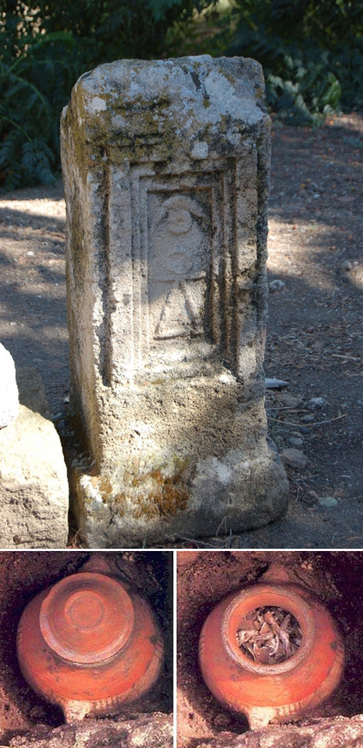Tophet of Carthage

Annotation
These images show a stone grave marker carved with symbols and a terracotta funerary urn containing the charred remains of an infant. The Tophet of Carthage is a cemetery for infants in the ruins of the North African city of Carthage, now located in a suburb of Tunis. It was once located on the edge of ancient Carthage, which was destroyed by the Romans in 146 BCE. The cemetery is the subject of historical controversy because both ancient texts and archaeological evidence point to the possibility that the children buried in the tophet were child sacrifices. The cemetery was used for over 600 years, between 730 BCE and 146 BCE. Changes in the grave markers and burials indicate three different periods of use.
The Carthage tophet has no adult graves, and many of the grave stelae are marked with dedications to Baal and Tanit, the patron deities of Carthage. The word tophet comes from the Hebrew topheth derived from "drum" or "place of burning," an open area for sacrifice. Numerous tophets have been identified in the eastern Mediterranean region. The Tophet of Carthage, excavated between 1920 and 1970, shows burials of young infants, interred in small vaults with beads and amulets, and sometimes the bones of small animals. Low thrones or stones marked the early graves.
In later periods, buried a layer above the original graves, sandstone markers were covered with stucco and painted yellow, red, or blue. Narrow, limestone grave stelae with pediments appear, inscribed with representations of Baal and Tanit. Many featured the sign of Tanit shown on the stela in the image—a triangle with a disc at the apex and a line through the apex with upturned ends, which looks perhaps like a child or a doll with outstretched arms.
Jewish and Christian scriptures refer to places of child sacrifice. Roman writer Diodorus Siculus described the sacrifice of upper class children to the deity Baal in 310 BCE, a reference seen as the main source of the claim of child sacrifice. Later elaborations made by writers even into the 19th century include the description of a metal fire pit in the form of the deity, with grates that mechanically tipped infants into the fire. Sacrifices to appease the deities or to ask favors seem to be supported by some inscriptions, but there may also be evidence that small animals were sacrificed in place of the children.
On the other side of the controversy are claims that the archaeological evidence is too sparse and inconclusive, and the texts may have been written out of ulterior motives, especially in view of Rome's wars with Carthage. No other classical sources mention the practice, and biblical references do not mention the tophet of Carthage.
There is also evidence that children's burial grounds were merely separated from adult cemeteries as well as pictorial evidence that the graves were regularly kept and supplied with offerings. The fact that burials were sometimes massed, and that some graves contain more than one child, may be evidence of disease epidemics as the population of Carthage grew. The inscriptions that refer to gifts and offerings may refer to sacrifice, or may refer to the hope of regeneration or fertility to the family who lost the child, meanings included in concepts surrounding both Tanit and Baal as deities.
Credits
Grave marker photograph by Natasha Sheldon, "The Tophet of Carthage," Archaeology, May 8, 2008; Terracotta urn photograph by James Whitred of the Punic Project, American Schools of Oriental Research (accessed January 6, 2010). Annotated by Susan Douglass and John Buescher.